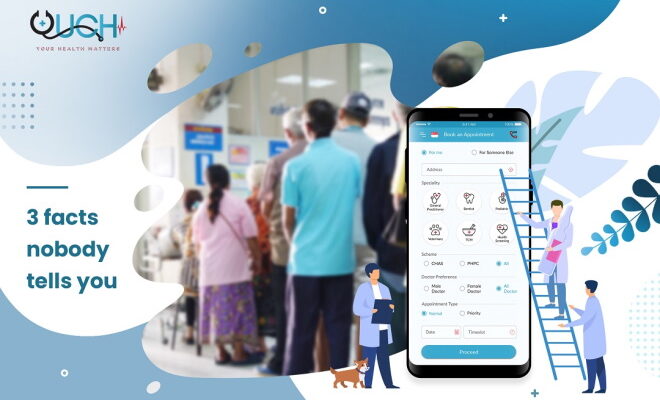
Health x Wellness
Ouch, a technology-aided healthcare app makes waiting at the GP obsolete
Patients continue to prefer face-to-face consultants with their doctors but find queuing for appointments and walk-in sessions a drag on their time. Ouch, a new to Singapore healthcare app seeks to reduce the impact of waiting time by offering features that improve the clinic visit experience.
Long waits at General Practitioner (GP) clinics are a pain point many of us are familiar with, regardless of whether it is for an appointment or a walk-in. GPs and their teams are simply dealing with too many patients at any given point of time.
In recent times, this situation has been exacerbated with the move toward endemic living, and guidance for patients to treat their GPs as their first port of call (and not hospitals).
How can long waits, amongst other on-the-ground problems, be solved?
Ouch, a free, tech-aided health app was recently introduced to the Singapore market to help answer the question.
From a positioning perspective, Ouch believes that many patients prefer face to face consultations with doctors in times of urgency and distress, and not remote consultations. The app’s feature set has a focus on helping users book highly customisable appointments and queue management functions.
This translates into users being able to easily schedule appointments in real-time. With the queue management system, patients no longer have to wait around the clinic, but will be updated live and notified once it is time for them to journey to their appointment. This feature can help reduce physical waiting times and minimise exposure risks.
Ouch has signed up over 100 participating CHAS clinics across multiple specialties such as GPs, dental, veterinary and Traditional Chinese Medicine clinics. Through the app, users can compare clinic pricing and distance to address their needs.
In addition, the app allows for in-app bill payment, saving the hassle and extra time taken with over-the-counter interactions.
We discussed this challenge of waiting for GP appointments, and how a healthcare app technology can make the situation better with Anil Kumar, Co-Founder of Ouch Inc.
the Active Age (AA): Why does Ouch feel that appointment taking and queuing is a pain-point for patients and doctors?
Anil Kumar (AK): Maybe it is a Singaporean thing, we seem to like waiting in the queue, and most people are fine with that. However, as a country that focuses so dearly on efficiency and productivity, we believe there ought to be a smarter way that reduces queue time, physical interaction and focuses on delivering better customer service.
It is frustrating for patients to wait (a long time) before being seen by the doctor, let alone the pain and agony associated with the illness. It is also equally vexing for clinic assistants to manage the queue (that is, walk-in and call-in) as they have to concurrently multi-task registration, dispensing medicine, keying invoices, assisting doctors, etc. The outcome of this usually meant the clinic assistants get overwhelmed during the peak hours, and they end up prioritising tasks over urgent matters.
The emergence of COVID has changed the way of life of most people. We have become more mindful about personal hygiene and touching physical surfaces. Singapore has an efficient and widespread system of healthcare by worldwide standards. In 2020, the Bloomberg Health-Efficiency Index, which tracks life expectancy and medical spending, ranked Singapore first in the world for the most efficient healthcare.
We believe the time is ripe to evolve and change how things are done currently.
Our vision is to help improve service quality with the automation of the current queuing scene at most clinics. We are working with several clinics on beta testing of our Queue Management System (QMS). The goal is to refine it further to reduce human intervention and make it as intuitive as possible.
AA: How does Ouch know that patients prefer face-to-face consultations, instead of the currently-encouraged remote and tele-health solutions?
AK: Candidly, the mainland of Singapore measures 50 kilometres from east to west and 27 kilometres from north to south. There are 2.6 doctors per 1,000 people on the island, making Singapore one of the most accessible healthcare professionals globally. Nevertheless, many Singaporeans still prefer in-person interactions over telehealth solutions with such ease and convenience.
Telemedicine visits are not a complete substitute for in-person visits; nor are they feasible for all patients or clinical situations. For example, technology does not always work smoothly, and technical difficulties may interfere with the delivery of care. A significant limitation is the inability to conduct an in-person physical examination. In addition, inaccurate dosing of weight-based drugs (e.g., chemotherapy treatments, pediatric medications) may occur due to the inability to weigh patients.
In addition, patient and provider perceptions and experiences may differ from those experienced during an in-person visit. It is essential to be aware of these potential differences. Many traditional office elements, such as touch, physical presence, and emotional connection, can be restricted by digital technologies. Some patients may have no prior experience with video visits and prefer in-person visits over video visits. Similar preferences for in-person interactions have been noted in specialist care services.
Telemedicine visits may not be appropriate or feasible for all patients or all clinical situations. Therefore, the clinician must use telemedicine services appropriately for care to be delivered effectively and accurately.
The “digital divide” can create potential disparities in access to participation in telemedicine, including for those with limited internet access, inability to apprehend newer technology, older adults, and those with diverse cultural settings and socioeconomics.
AA: What would be the ideal scenario for a patient in the Singapore system, and how does Ouch seek to create this scenario for them?
AK: We are catering to the growing digital population seeking and valuing transparency, responsiveness, and assurance while solving issues with the traditional supply and demand model.
Instead of focusing on a specific stakeholder (that is, either patients or doctors), we acknowledge users’ different needs and requirements as we attempt to “match-make” the two ends with a favourable outcome.
- Service providers: Ouch offer a new way of responding to the increasing demand for medical care. As the Baby Boomer population ages, costs rise, and shortages of primary and specialist doctors, as well as nurses and therapists loom, Ouch offers providers a new way to cope with unprecedented demand.
- Patients: Ouch offers a streamlined experience that allows them to resolve any issues or concerns like booking appointments quickly, paying bills, viewing history or checking account status whenever, wherever, and however is most convenient for them. With improved living standards (compared to the past), consumers are now actively engaged in their healthcare, and there are increasingly greater expectations for high-quality service from providers. If the experience does not address their unique pain points, consumers will question whether the services from healthcare providers are worth their hard-earned money.
- Employers: Ouch provides a digital platform addressing their workforce’s local healthcare needs, creating a workforce health strategy that will improve productivity, reduce OPEX, and attract as well as retain talent.
AA: How can Ouch’s technology mitigate pain points for both clinics and patients?
AK: We have always been very engrossed (at least I am) in getting the Human Machine Interface (HMI) right from the beginning. Simply put, HMI provides the controls that allow a user to operate a system. When done well, they create easy, reliable accessibility and make the function of technology simple and effective. Or, in plain English, the effectiveness of the HMI can affect the acceptance of the entire system.
Till today, we are still continuing to refine our solution based on feedback from patients, clinics, doctors and even suppliers. The end goal is to make Ouch as intuitive and easy for patients to use while maintaining a high level of cybersecurity to protect sensitive data falling into the wrong hands.
We advise clinics and doctors to come onboard using our cloud-based solution instead of managing a customised IT system in-house, which can be costly, time-consuming, and inept to adopt future changes.
We’ve always advocated to clinics and doctors that their focus should be on building stronger affinity with their patients while improving the quality of service with seamless delivery.
Leave the IT system to us, and that includes training, and we believe our attention to detail on HMI makes it very easy for anyone to familiarise and onboard with the system.
AA: What’s in the roadmap for Ouch going forward?
AK: We are releasing a beta version of our Queue Management System (QMS), which shall be free for all clinics to use. We are currently working with several charitable organisations to roll it out to all their clinics island-wide. This is a big challenge as we will be working closely to ensure our silver and pioneer generation knows how to use it and enjoy the benefits of what technology has to offer.
We want to champion the change in going digital with virtual queue and play a part in battling the current pandemic. Together, we will be much better prepared even when new COVID variants emerge.
[We have coming up a] Group Medicine Purchase (GMP) which allows clinical practitioners to take advantage of better-priced medicine available when making bulk purchases. The savings allow businesses to free up capital expenditure and strengthen cash flow, reducing the gearing ratio or investing in medical equipment.
We welcome clinics or doctors keen to participate in our beta testing for either QMS or GMP, or both! They can reach out to us and indicate their interest. We value all feedback, which drives us to create a compelling market product to better serve the community.
Access and availability: Ouch has over 100 clinics registered on the app, which has seen close to 10,000 downloads to date. It can be downloaded from Google Play and App Store (Apple) for free.

Images credit to Ouch Inc.







